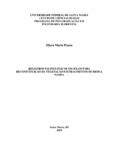| dc.creator | Piazza, Eliara Marin | |
| dc.date.accessioned | 2021-05-19T17:02:42Z | |
| dc.date.available | 2021-05-19T17:02:42Z | |
| dc.date.issued | 2019-02-27 | |
| dc.identifier.uri | http://repositorio.ufsm.br/handle/1/20926 | |
| dc.description.abstract | Pampa biome vegetation is characterized by extensive areas of native grasslands interspersed
by forests close to water courses. There is a great effort on the part of researchers to understand
the grassland and forest dynamic so that appropriate conservation and management actions are
proposed for the biome. In this sense, the present work aimed to perform a palynological record
in order to reconstitute a model of past vegetation in an ecotone region in the Pampa biome.
For this, four mineral soil profiles were selected in the municipality of São Gabriel, RS, Brazil.
The collected soil samples were fractionated into 1cm3 and then processed according to
standard methodology in palynology. The palynological analyzes were supported by
radiocarbon dating and particle size analysis. The results indicated that the forestry horticulture
of Cerro do Batovi was naturally composed of grassland vegetation from 4090 ± 25 years BP.
The grasslands were mainly covered by grasses such as Poaceae and other herbs which
inhabited open environments. In the Santa Olga forest, the grassland and forest vegetation
divide space at least 2630 ± 25 years BP, however the grassland elements dominated the pollen
spectrum. The particle size data indicated that the particle size of the soil exerts a direct
influence on the representativeness of the pollen collection. The results will contribute to better
understand the current floristic pattern of the Pampa biome, favoring development of
conservation strategies. In addition, this work extends the frontier of palynological research, as
well as knowledge about the potential of soil use in paleoenvironmental studies, being the first
work in palynology to use mineral soils as a sampling site. | eng |
| dc.language | por | por |
| dc.publisher | Universidade Federal de Santa Maria | por |
| dc.rights | Attribution-NonCommercial-NoDerivatives 4.0 International | * |
| dc.rights.uri | http://creativecommons.org/licenses/by-nc-nd/4.0/ | * |
| dc.subject | Palinologia | por |
| dc.subject | Paleovegetação | por |
| dc.subject | Análise polínica | por |
| dc.subject | Granulometria | por |
| dc.subject | Holoceno | por |
| dc.subject | Palynology | eng |
| dc.subject | Paleovegetation | eng |
| dc.subject | Pollen analysis | eng |
| dc.subject | Granulometry | eng |
| dc.subject | Holocene | eng |
| dc.title | Registros palinológicos em perfis de solos para reconstituição da vegetação no bioma Pampa | por |
| dc.title.alternative | Palynological records in soil profiles for reconstituting vegetation in the Pampa biome | eng |
| dc.type | Tese | por |
| dc.description.resumo | A vegetação do bioma Pampa caracteriza-se por extensas áreas de campo nativo, entremeadas
por florestas próximas a cursos d’água. Existe um grande esforço por parte de pesquisadores
em compreender a dinâmica campo e floresta, para que sejam propostas ações de conservação
e manejo adequadas ao bioma. Nesse sentido, o presente trabalho objetivou realizar um registro
palinológico, a fim de reconstituir um modelo de vegetação pretérita em região de ecótono no
bioma Pampa. Para tanto, foram selecionados quatro perfis de solos minerais no município de
São Gabriel, RS. As amostras de solo coletadas foram fracionadas em 1 cm3 e, posteriormente,
processadas conforme metodologia padrão em palinologia. As análises palinológicas foram
apoiadas por datações radiocarbônicas e análises granulométricas. Os resultados indicaram que
o horto florestal Cerro do Batovi foi naturalmente composto por vegetação campestre desde
4090 ± 25 anos AP. Os campos eram recobertos, principalmente, por gramíneas como Poaceae
e por demais ervas que habitavam ambientes abertos. No horto florestal Santa Olga, a vegetação
campestre e florestal divide espaço há pelo menos 2630 ± 25 anos AP, entretanto, os elementos
campestres dominaram o espectro polínico. Os dados da granulometria indicaram que o
tamanho das partículas do solo exerce influência direta sobre a representatividade do conjunto
polínico. Os resultados encontrados contribuirão para melhor compreensão do atual padrão
florístico do bioma Pampa, favorecendo o desenvolvimento de estratégias de conservação.
Além disso, este trabalho amplia a fronteira de pesquisas palinológicas, bem como o
conhecimento sobre o potencial de uso do solo em estudos paleoambientais, sendo o primeiro
trabalho em palinologia a utilizar solos minerais como sítio de amostragem. | por |
| dc.contributor.advisor1 | Reichert, José Miguel | |
| dc.contributor.advisor1Lattes | http://lattes.cnpq.br/0910765178697312 | por |
| dc.contributor.referee1 | Schenato, Ricardo Bergamo | |
| dc.contributor.referee1Lattes | XXXXXXXXXXXXXXX | por |
| dc.contributor.referee2 | Redin, Cristina Gouvêa | |
| dc.contributor.referee2Lattes | XXXXXXXXXXXXXX | por |
| dc.contributor.referee3 | Lima, Gisele Leite de | |
| dc.contributor.referee3Lattes | XXXXXXXXXXXX | por |
| dc.contributor.referee4 | Bauermann, Soraia Girardi | |
| dc.contributor.referee4Lattes | XXXXXXXXXXXXXXX | por |
| dc.creator.Lattes | http://lattes.cnpq.br/6413677446320447 | por |
| dc.publisher.country | Brasil | por |
| dc.publisher.department | Recursos Florestais e Engenharia Florestal | por |
| dc.publisher.initials | UFSM | por |
| dc.publisher.program | Programa de Pós-Graduação em Engenharia Florestal | por |
| dc.subject.cnpq | CNPQ::CIENCIAS AGRARIAS::RECURSOS FLORESTAIS E ENGENHARIA FLORESTAL | por |
| dc.publisher.unidade | Centro de Ciências Rurais | por |



